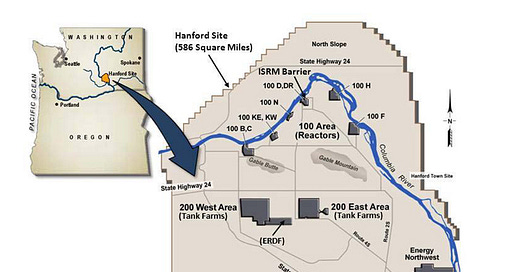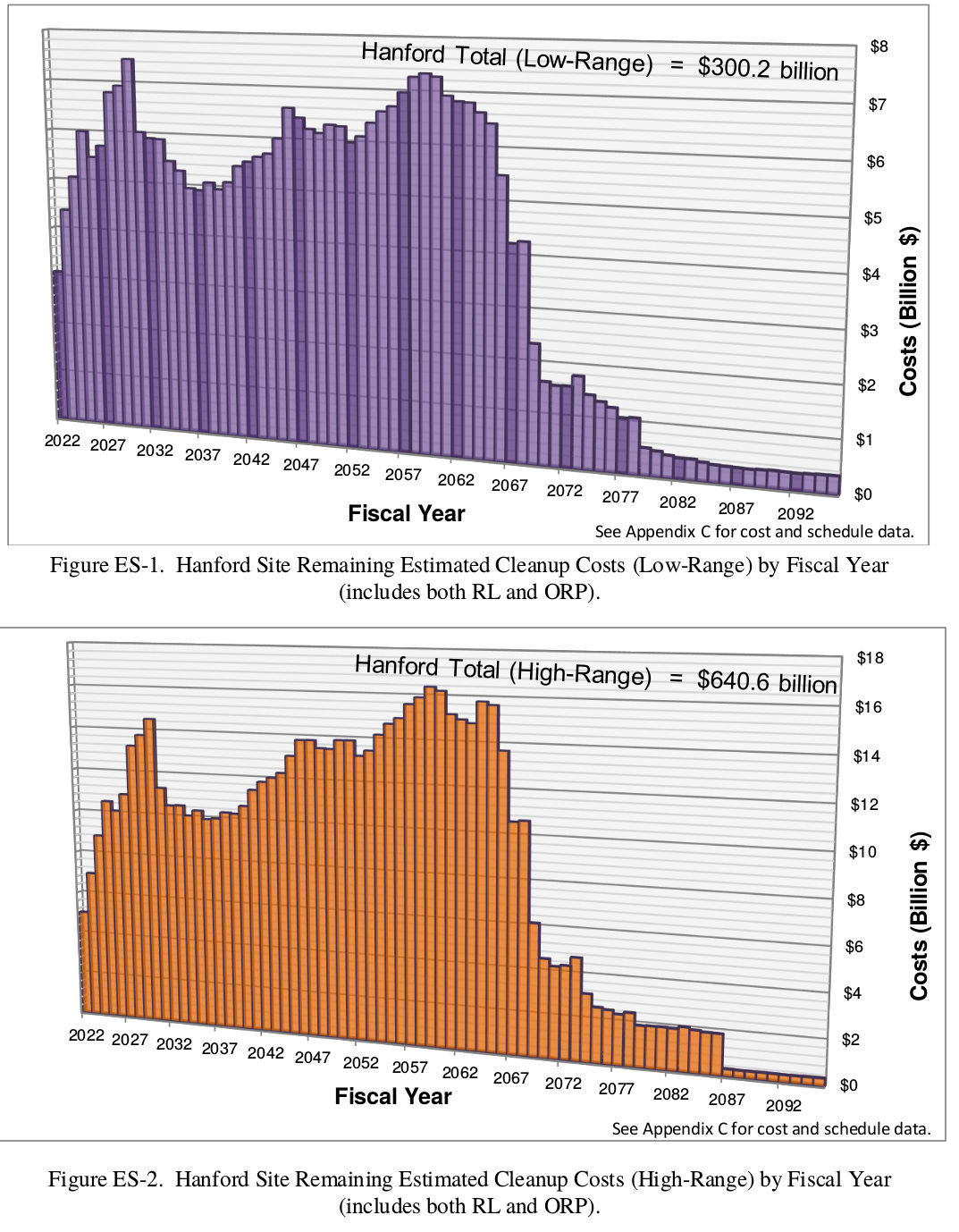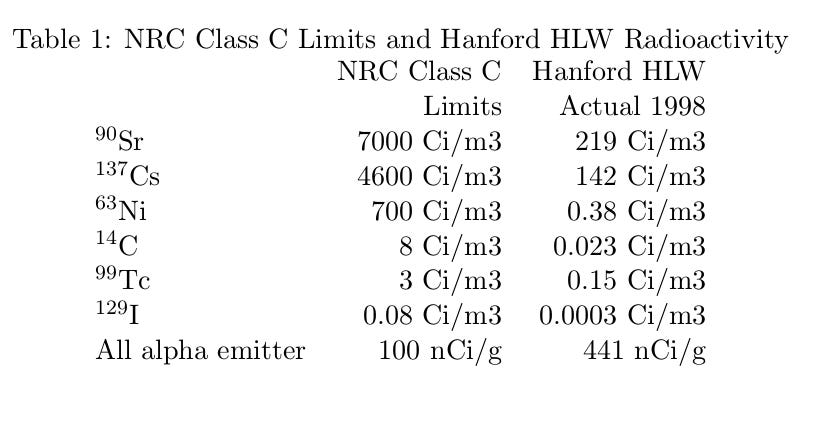Correction: the tritium piece claimed natural production of tritium was 1000 times nuclear power production. This is incorrect. They are roughly the same. Mixing kilograms and grams. Mea culpa, Jack
This piece covers only the largest of the nuclear waste boondoggles you and I are paying for. In every case, the nuclear establishment has chosen to spend as much taxpayer money as possible for as long as possible. In order to support this monumental rip off, they need to convince you and me that dose rates just slightly above background are so harmful that we should spend billions of dollars per year to ineffectively try and reduce them further. To do this, they need LNT and the Catastrophic Harm Line.
As usual, a more detailed, properly referenced version is at gordianknotbook.com.
What's the fattest pork, the biggest, most outrageous boondoggle, you have never heard of? Consider the Hanford clean up program. Hanford, Washington is a government reservation where weapons grade plutonium was produced from 1944 to 1986. Hanford is located on about 40 miles of the Columbia River, Figure 1, from which it drew the water needed to cool the plutonium production reactors and the purification processes.
Figure 1. Map of Hanford Reservation
Early on, little attention was paid to avoiding spills and leaks. Contaminated water was disposed of in trenches or open bottom cribs and allowed to percolate into the soil or routinely released back to the river. A wide area was contaminated with ``deadly" radiation. As a result, 10,000 people are employed in cleaning up Hanford. The program is costing the taxpayer about 2.5 billion dollars per year. Figure 2.
Figure 2. Hanford Annual Cleanup Costs, 2020 dollars
Maybe that doesn't impress you. OK, guess how much it will take to finish the job. The Department of Energy says between 300 and 640 billion dollars, Figure 3, and fifty years.
Figure 3. Hanford Cleanup Projected Costs
So we are talking about half a trillion dollars, give or take a 100 billion or so. And this is a government projection. Already we have spent more than 60 billion dollars “cleaning up” Hanford and have essentially nothing to show for it. Maybe we should ask ourselves, just how deadly is this deadly contamination.
In 2003, the State of Washington and DOE did a joint survey of the radiation levels on the Hanford river front. They determined that the average background radiation along the river was 0.7 mSv/year. This is at the very low end world wide. The planet average is about 2.4 mSv/year. The team took thousands of measurements, concentrating on known hot spots. Most of the measurements were below 1.0 mSv/y; but they did find a few spots where the numbers skyrocketed to 1.2 mSv/y. In other words, the worst case dose rates along the Hanford river front are less than average background worldwide.
Inland it's the same story. Hanford is fitted with about 120 permanent radiation monitors clustered around the old processing and storage facilities. Table A shows the measured dose rates for 2011 and 2012. Most of the measurements are at or near background in a low background environment. There are a few measurements in the 2 to 3 mSv/y range and one at about 6 mSv/y. All the measurements are below the average background dose rate in four states.
So why are you and I paying 2.5 billion dollars per year to try and push these dose rates still lower?1
The answer is the Catastrophic Harm Lie. To keep this money flowing, the nuclear establishment must claim that dose rates that are a millisievert or two per year above background in a low background environment are so harmful that we should spend billions of dollars per year to ineffectively try and reduce them further.
Under the Catastrophic Harm Lie, the EPA legal limit for drinking water is 0.15 mSv/y, for a person drinking 2 liters per day every day for 365 days from the worst case well. When Hanford did the required Environmental Impact Study on the tank clean up program, by law they had to include a Do Nothing option. The worst case dose rate for this well user for the walk-away option was 0.59 mSv/y in 4313. 0.59 mSv/y exceeds 0.15 mSv/y. Ergo, spend tens of billions of dollars. I suppose if the EPA limit had been 0.6 mSv/y, we could have saved all that money.
The Hanford High Level Waste
The great volume of the radioactive waste at Hanford is the uranium, fission products and transuranics that were left over after the plutonium was separated from the spent fuel that came out of the reactors. There's about 290,000 tons of it. It is currently stored in 177 underground tanks, Figure 3.
Figure 3. Hanford Tanks Under Construction
The tanks are concrete with a steel liner. 149 of the tanks built prior to 1964 have single shell liners; the rest are double shell, Figure 4. 67 of the single shell tanks tanks have leaked an estimated 3800 m3. None of the double shell tanks have leaked to the ground.
Figure 4. Hanford Single Shell and Double Shell Tanks
At the core of the Hanford boondoggle is the distinction between high level waste (HLW) and low level waste (LLW). High Level Waste is radioactive material that is deemed so dangerous under the Catastrophic Harm Lie, it must entombed for millions of years in a deep geologic repository. NRC Class C Low Level Waste can be land filled in a fancier than usual landfill. Table 2 compares the NRC's Class C requirements with the Hanford High Level Waste. Ci/m3 and nCi/g are measures of the waste's radioactivity. The NRC limits are based on the fundamentally incorrect LNT hypothesis combined with a long line of excessively conservative assumptions. But for now let's play lawyer and just focus on the legalities.
The Hanford HLW comfortably meets all the NRC Class C requirements except for the alpha particle emitters. But in 600 Year Old Spent Nuclear Fuel is Just Another Poison we found out that alpha particle emitters must be swallowed to be harmful. As long as we can keep people from eating or drinking this stuff, it can be landfilled.
In the Hanford case, the obvious place to landfill the waste is in the tanks where it currently resides. The material can be immobilized by mixing it with a cement containing finally ground phosphate rock sand, and pumping it back into the tank where it will solidify. Uranium and transuranic phosphates have extremely low solubility in water. Even if the tanks were somehow flooded, the alpha emitters would stay in the tank. To keep the lawyers happy, we will need to dilute the waste by a factor of 4.4. We will end up with 454,000 m3 of Class C legal material, which will comfortably fit in the 650,000 m3 tank volume. Total cost, even at government rates, maybe a billion dollars.
Hanford is an excellent storage location. It was one of the three finalists for the deep geological repository. The tanks are 50 meters above the water table in one of the driest deserts in America, and at least 11 miles from the Columbia River. And there is a certain equity involved. Hanford locals would have us move the Hanford waste from their desert to somebody else's desert. But the Hanford area has fed at the public trough for 80 years. If there is any burden associated with storing a material that has been rendered innocuous, Hanford should bear it.
Columbia River Contamination
A big concern with the Hanford waste is its getting to the Columbia. Table 2 shows the contamination in the river upstream and downstream from Hanford. The numbers shown are the maximum concentrations found in 13 different samples. The upstream levels are natural background numbers.
The only isotope which is significantly higher downstream is tritium. Tritium, a very weak electron emitter, is not a health hazard at 100 times the EPA drinking water limit of 20,000 pCi/L, and the downstream concentration is 400 times below that limit. However, some tritium is still getting into the river, doubling the natural background levels.
Tritium was created in the cooling water streams in both the reactors and the subsequent fuel processing. This water was discharged into open bottom cribs and trenches and allowed to percolate down into the ground water. Tritium is just another form of water, and moves with the ground water toward the river at very roughly 250 meters per year (2 ft/day). Tritium has a half-life of 12 years. The inland edge of the main remaining tritium plume is now about 8 km from the river, Figure 5. In another 40 years, if we do nothing, the tritium levels in the river downstream of Hanford will approach natural background levels.
Figure 5. Hanford Tritium Plumes, 1980 and 2019
When does clean up become corruption?
It is hard to avoid the conclusion that the Hanford program has morphed from an unnecessary, ineffective cleanup to a deliberate, monumental, half-trillion dollar ripoff of the taxpayer. When the immobilize and store in tanks plan was proposed to Hanford management in 2013, it was rejected. Since then nothing much has happened, other than the disappearance of another $15 billion of taxpayers' money while we wait for the government to spend $500 billion or more of our money to do what? This is not incompetence; it is corruption, feeding on bogus fears that the nuclear establishment itself has created.
Trying and failing. The 2012 numbers in Table A on average are 7% higher than 2011. Overall the numbers at Hanford have tracked the half life of Cesium-137, the main remaining photon emitting isotope. Most of the work just moves radioactive material from one place to another. Unless you put the material in a reactor and transmute it, you can change neither the amount nor the type of radiation you are dealing with.













I finally got around to reading the full 'Why Nuclear Power has been a Flop' book and I am absolutely reeling at how good it is. Thank you Jack, for your past and continuing work in this space.